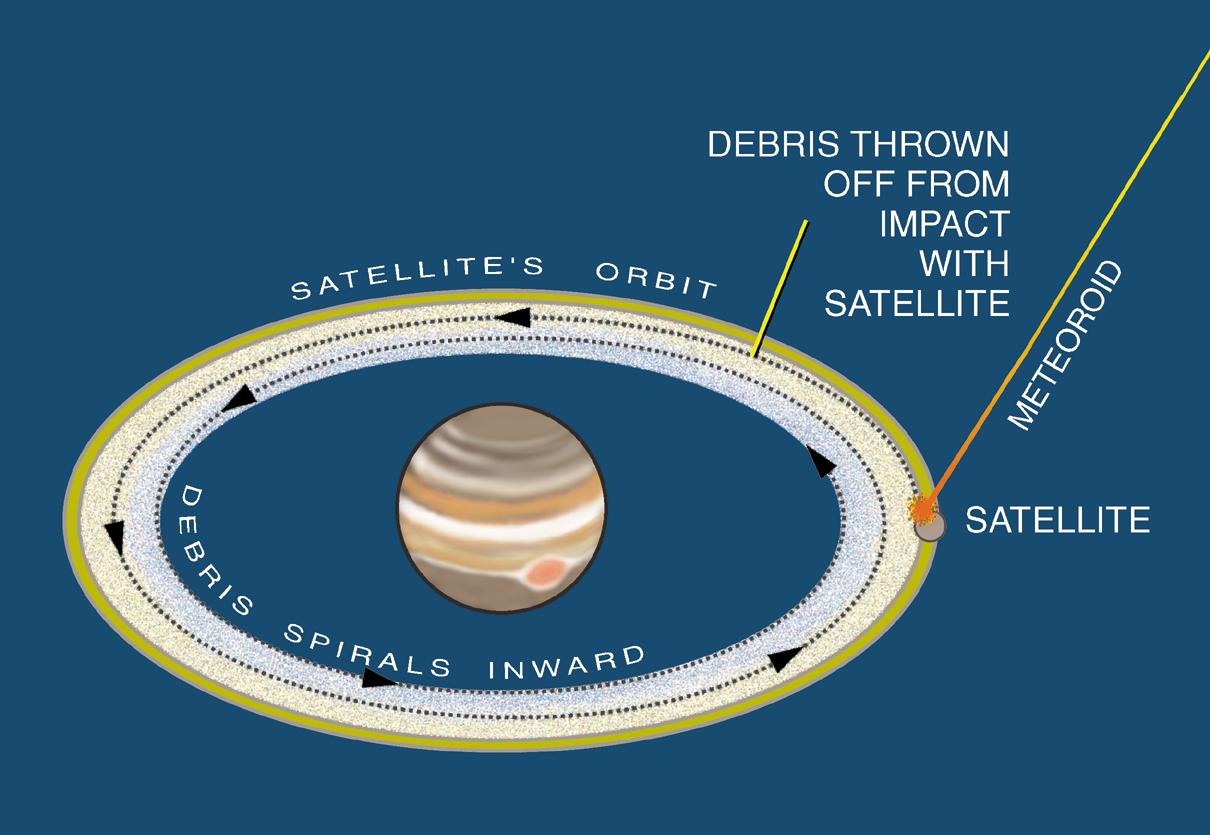-
 Jupiter from HST with Io its innermost large moon and Io's shadow.
Jupiter from HST with Io its innermost large moon and Io's shadow.
It think this is approximately true color, but you never know.
Credit: NASA.
-
 Jupiter from HST. 1995feb13.
Jupiter from HST. 1995feb13.
This image is probably close to true color, but perhaps the colors are enhanced to emphasize features.
One can see the dramatic band structure of Jupiter.
The Great Red Spot is giant anticyclonic storm. It's longest dimension is about twice the Earth's diameter (Se-499).
The Spot may have existed in the 17th century, but has certainly been identified since the 19th century.
There are also three white ovals which are smaller anticyclonic storms???. The outer two formed in the 1930s.
Essentially, it is the huge nature of Jupiter that causes its weather features to be so enduring by comparison to Earth.
See the official caption for more information.
Credit: NASA/HST.
-
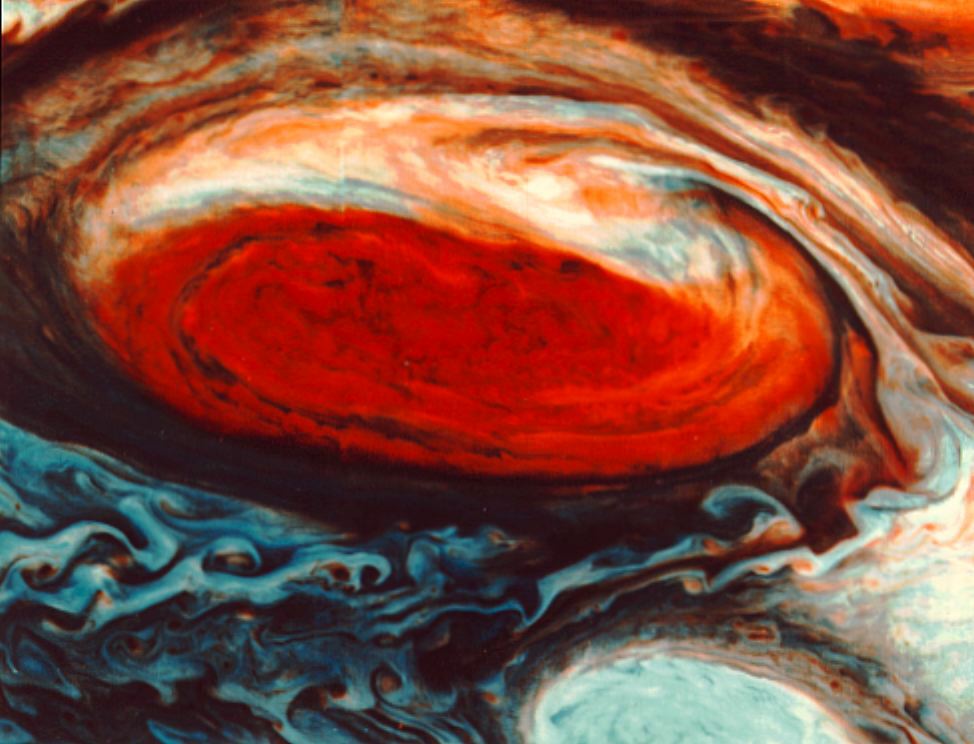 Jupiter's Great Red Spot in false color from Voyager 1979jun06.
Jupiter's Great Red Spot in false color from Voyager 1979jun06.
North is at the top and bottom to top is 24,000 km.
The colors enhance reds and blues and suppress greens.
As one can see, a complicated turbulent flow around the big vortex.
See the official caption for more information.
Credit: NASA/HST.
-
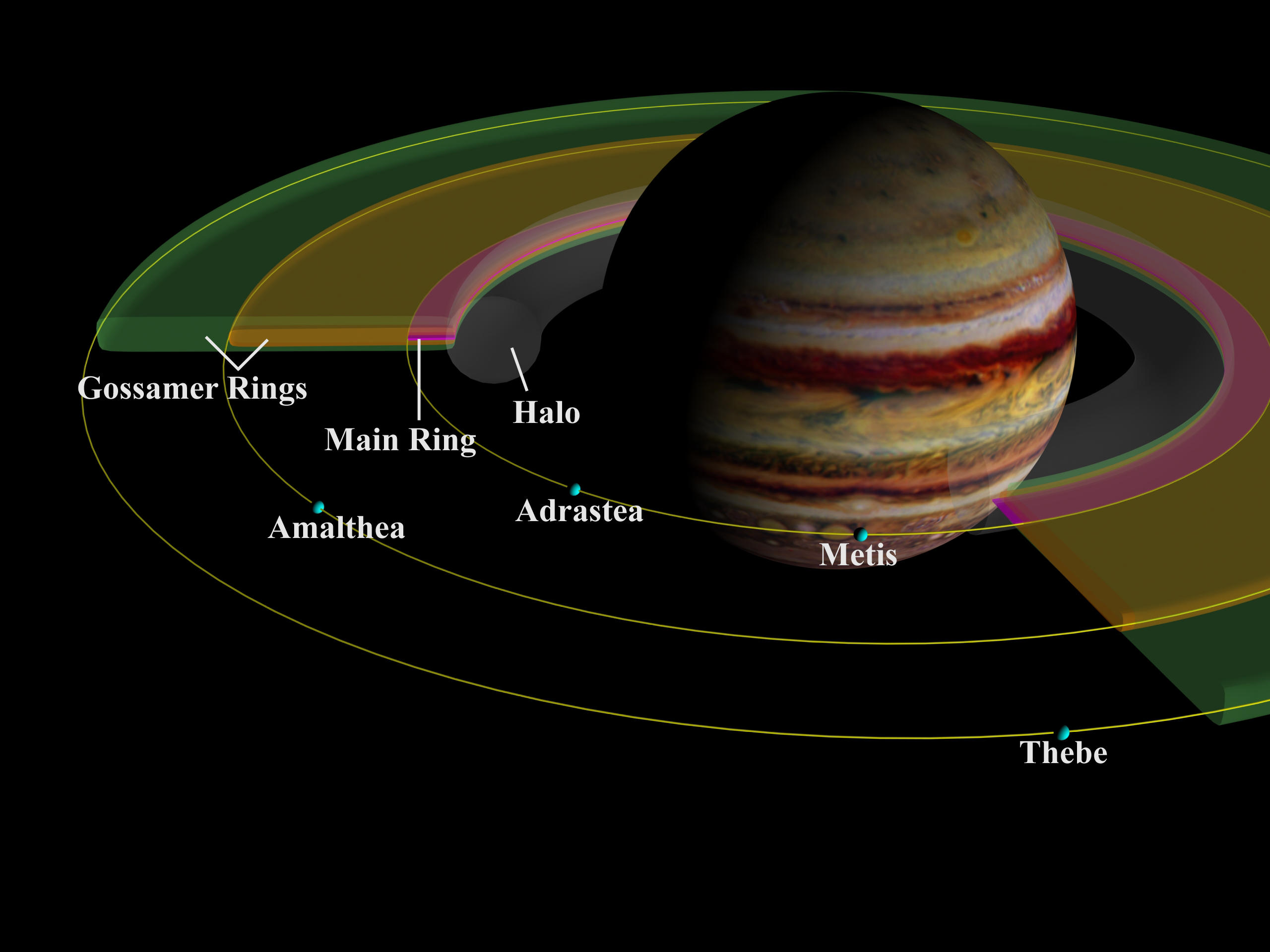 A diagram of Jupiter's ring system.
A diagram of Jupiter's ring system.
The main ring is the most visible of ring of the system.
The gossamer rings and thick halo are very transparent.
The rings are probably made of dark rocky dust that is knocked off Jupiter's inner minor moons by meteoritic impacts.
The small moons Adrastea, Metis, Thebe, and Amalthea are all closer to Jupiter than the closest large moon Io.
The dust grains may have size scale of order 10 microns (SRJ-227).
Jupiter's tidal force keeps the dust from coalescing into clumps under the dust's own gravity or falling back onto the moons.
The ring material is actually believed to be spiralling into Jupiter and must be continuously replenished (HI-210). Some perturbations must account for the in-spiral.
The rings of Uranus and Neptune and Cassini's division about Saturn are believed to also be rings of the same nature as those of Jupiter (HI-209,232-234).
Credit: NASA for both images.
-
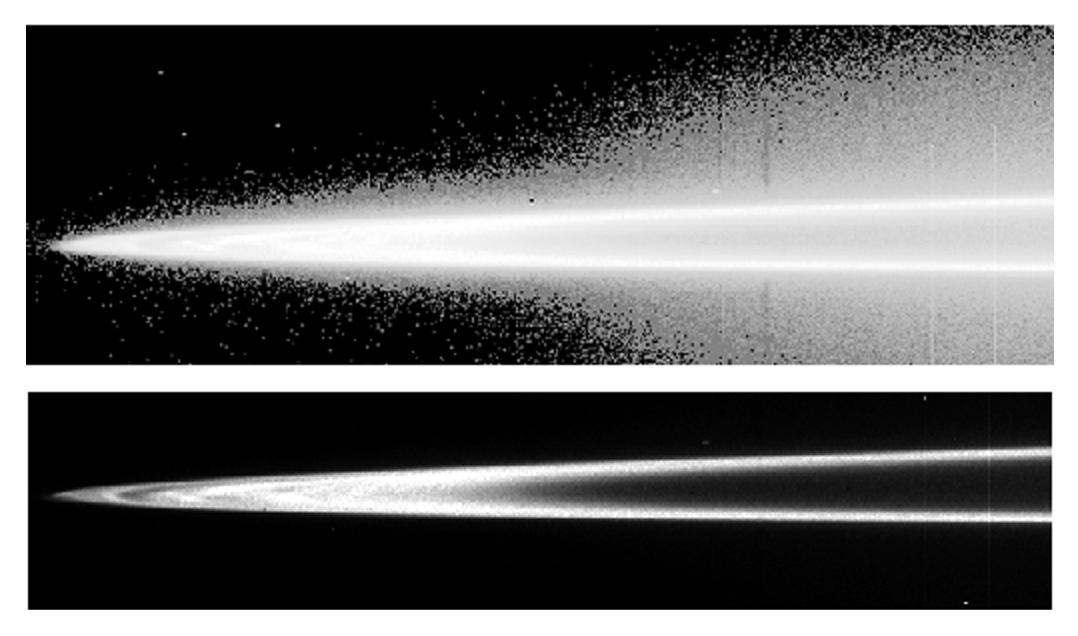 A Galileo mosaic of Jupiter's main ring and halo in two panels.
A Galileo mosaic of Jupiter's main ring and halo in two panels.
The two panels use different lighting scales so that the top one brings out the halo.
The image was taken under dark conditions when Galileo was eclipsed by Jupiter. This is necessary since the rings are dark and reflect very little light.
Rings are usually very flat.
The halo is vertically extended because electromagnetic forces acting on the charges on the ring particles keep the particles pushed out of the plane.
Because of its strong magnetic field and complex flows of ions from the solar wind and outgassing from Io, Jupiter has a pretty complicated electromagnetic environment.
Credit: NASA.
-
Jupiter's Galilean satellites in collage.
The Moons are in their right relative positions (inner to outer Io, Europa, Ganymede, Callisto), but not to scale. The images were taken by Voyager 1 in 1979mar.
Credit: NASA.
-
 Io in approximately true color. Galileo, 1999jul03.
Io in approximately true color. Galileo, 1999jul03.
On the image 3 km features can be resolved.
Io is the innermost of the Galilean moons to Jupiter. Mean distance 5.903 Jupiter equatorial radii.
Io's radius is 1820 km; its diameter is 3640 km. (But note Io isn't very round due to tidal bulging). In spatial scale, Io is the 8th largest rocky/icy body in the solar system: the first 7 are Earth, Venus, Mars, Ganymede (another Galilean moon), Titan (a moon of Saturn), Mercury, and Callisto (another Galilean moon).
Io's rotational period is 1.769137786 days and it is synchronously tidally locked to Jupiter: i.e., it always turns the same face to Jupiter.
Io's mean density is 3.55 g/cm**3 and this means it must be mainly silicates: i.e., rock.
The blacks and reds mark volcanic features. They are sulfur compounds. The white is solid sulfur dioxide. The green is ???: sulfur compounds too I suppose.
Molten sulfur lava is black and solidified sulfur lava is red or orangy or yellowy (HI-216).
Io is the most geologically active body in the solar system with the geology being driven by tidal flexing due to Jupiter. Many large-scale features have altered even during the lifetime of the Galileo mission.
-
[Because it is a small body, the residual heat of formation
and past and present radioactive heat are completely
insufficient to give Io active geology.
Io has no (or almost no) significant impact craters since its surface is continually being renewed.
The flexing occurs even though Io's orbital and rotational periods are synchronized so that Io always turns the same face to Jupiter.
The other Jovian moons keep Io's orbit from being perfectly circular. The tidal flexing occurs as Io moves closer and farther from Jupiter.
Io by several kilometers along the Io-Jupiter line. The tidal flexing causes the surface of Io to rise and fall in places by about 100 m.
The interior of Io must be molten sulfur, rock, and metals.
The surface is cold away from the volcanoes: maybe 80 to 150 K. The lava temperatures are typically 400 to 600 K, but some be has hot as 2000 K (HI-215)
Io long ago has lost its volatiles such as hydrogen, helium, water, and CO_2.
On Io the lavas are sulfur, sulfur compounds, and, for the hottest volcanoes, silicates.
The gas which explosively evaporates from liquid to gas when the pressure of the lava falls as it rises to the surface is SO_2. In terrestrial volcanoes it is water fulfills this role.
The plumes of sulfur ash can rise up 100 km and some material escapes Io altogether.
See FMW-234, HI-215, Se-508, and Cox-303--307.
Credit: NASA. That the color is true is confirmed by NASA: Astrophysical Picture of the Day.
-
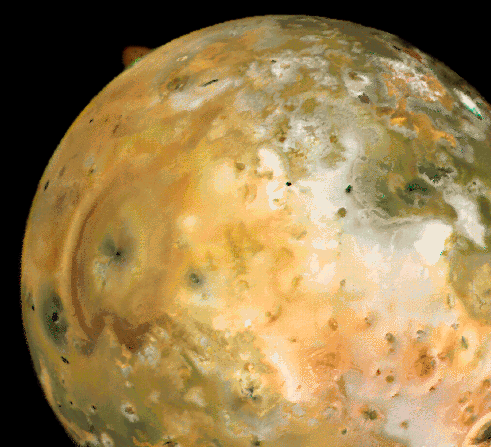 Io with a volcanic eruption.
An old Voyager image showing a volcanic explosion on Io.
This amazed everyone 20 years. Io is geologically super-active
with sulfur-spewing volcanoes.
Tidal flexing by Jupiter keeps the interior of Io hot and
active.
The surface is continually renewed.
Credit: NASA.
Io with a volcanic eruption.
An old Voyager image showing a volcanic explosion on Io.
This amazed everyone 20 years. Io is geologically super-active
with sulfur-spewing volcanoes.
Tidal flexing by Jupiter keeps the interior of Io hot and
active.
The surface is continually renewed.
Credit: NASA.
-
 Io with two volcanic eruptions.
This is a Galileo probe image from 1997nov17.
Two eruptions are seen: one on the limb and one near the
center close to the terminator with a shadow extending to
the right.
North is at the top. The resolution is about 2 km.
Io with two volcanic eruptions.
This is a Galileo probe image from 1997nov17.
Two eruptions are seen: one on the limb and one near the
center close to the terminator with a shadow extending to
the right.
North is at the top. The resolution is about 2 km.
The colors are false I think. But Io is very colorful because of all the sulfur and sulfur compounds.
The Io surface is largely sulfur and sulfur dioxides and silicates.Credit: NASA.
-
 Europa: the 2nd innermost moon. Voyager 1, 1979mar04.
Europa: the 2nd innermost moon. Voyager 1, 1979mar04.
This is a 3-color filter image, that may be close to true color: i.e., an orangy, off-white (SRJ-218, HI-217).
From a distance the surface looks bland except for the crinkly fractures that extend up to of order 3000 km and are about 100 km wide. The fractures are only of order 100 m deep.
The variation in height is small on Europa which gives it a smooth appearance.
But looked at closely there are all kinds of fine features which we won't consider in detail here.
Europa is the 2nd of the Galilean moons of Jupiter moving outward. Its mean distance 9.386 Jupiter equatorial radii.
Europa's radius is 1565 km; its diameter is 3130 km. In spatial scale, Callisto is the 10th largest rocky/icy body in the solar system: the first 9 are Earth, Venus, Mars, Ganymede (another Galilean moon), Titan (a moon of Saturn), Mercury, Callisto (another Galilean moon), Io (another Galilean moon), and the Moon.
The orbital period is 3.551181041 days and Europa is synchronously tidally locked to Jupiter: i.e., it always turns the same face toward Jupiter
The mean density is 2.970 g/cm**3 which indicates that Europa is probably mainly silicates although the surface is mainly water ice.
Europa probably chemically differentiated. There may be an iron core and rocky mantle. On the surface is an icy layer that may be of order 100 km thick (HI-217).
The comparatively bland surface has few impact craters and is probably less than a few hundred million years old.
This implies resurfacing is ongoing today.
Perhaps the fractures are due due to flexing by the tidal force. But the Galileo orbiter saw no fracturing during its lifetime, and so the time scale must be longer than a few years.
When the fracturing occurs, the surface stretches and cracks and liquid water from below wells up and then freezes on the surface.
On the other hand or in addition there may be ICE VOLCANOES that break up the surface with ``lava'' flows of water.
In any case over time, there is resurfacing.
Note that liquid water from below is needed in this scenario.
Tidal flexing of the interior must be heating Europa inside, but significantly less than in the case of Io. This is understandable Io is closer in to Jupiter where the tidal force is stronger.
There may be an ocean of liquid water 10 km or more in thickness below the icy surface.
If liquid water exists, then there is a possibility of life. This is a very exciting prospect.
On the other hand the water may be far to acidic for life as we know. Circa 2004 someone??? has proposed that Europa water is full of stuff like sulfuric acid (H_2SO_4) from sub-surface volcanism.
There is still a great deal of uncertainty about Europa's structure and evolution.
See the official caption, but note it is out-of-date in many respects. See also HI-216, SRJ-218, Se-506, and Cox-303--307.
Credit: NASA/Voyager 1.
-
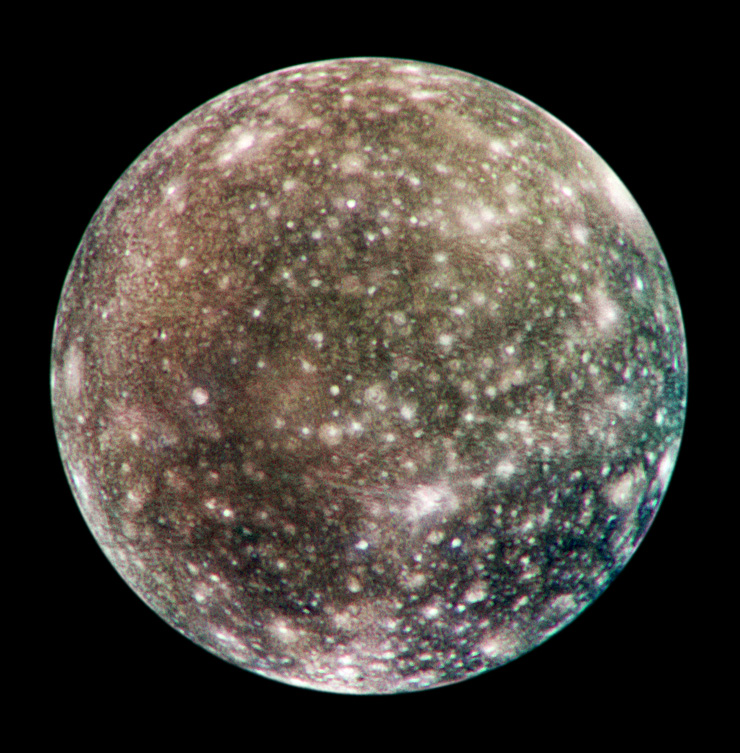 Callisto in true color????. Galileo image from 2001may.
Callisto is the outermost of the Galilean moons to Jupiter.
Mean distance 26.34 Jupiter equatorial radii.
Callisto in true color????. Galileo image from 2001may.
Callisto is the outermost of the Galilean moons to Jupiter.
Mean distance 26.34 Jupiter equatorial radii.
Callisto's radius is 2403 km; its diameter is 4806 km. In spatial scale, Callisto is the 7th largest rocky/icy body in the solar system: the first 6 are Earth, Venus, Mars, Ganymede (another Galilean moon), Titan (a moon of Saturn), and Mercury.
The orbital period is 16.6890184 days and Callisto is synchronously tidally locked to Jupiter: i.e., it always turns the same face toward Jupiter
Callisto mean density is 1.790 g/cm**3 and this means it must be a mixture of silicates and water ice.
-
[Recall silicates typically have a density of order 3 g/cm**3
and water ice has density of almost exactly 1 g/cm**3.]
Callisto is probably about half water ice and half silicates. There is probably a rocky/iron core, a rock/ice mantle, and an ice crust???.
But micrometeoritic impacts have probably vaporized the surface ice leaving superficial layer of carbonaceous regolith.
Bright spots are relatively recent impact craters that have exposed underlying ice.
Crater counts (including old dark ones) suggest that Callisto's surface has not been renewed since about 4 Gyr. Thus, there is probably little internal-heat geology.
But Callisto does have a weak magnetic field. It has been suggested that there is a dynamo effect due a subsurface of ocean of water in which electrical currents flow due to ions in the water.
See HI-220 and Cox-303--307.
Credit: NASA.
-
 Collage Jupiter's inner moons Thebe, Amalthea, and Metis.
Galileo probe, 1997nov.
Collage Jupiter's inner moons Thebe, Amalthea, and Metis.
Galileo probe, 1997nov.
Jupiter has 4 small moons within the orbital radius of the innermost Galilean moon Io: Metis, Adrastea, Amalthea, and Thebe. Adrastea is missing from the collage.
In the image north is approximately up in the images and the moons are in their correct relative sizes.
In the image counting downward are Thebe (1, 2), Amalthea (3, 4), and Metis (5).
The two Thebe images are rotated by 50 degrees. The large Crater Zelthus is on the far side of Thebe: i.e., on the hemisphere permanently turned away from Jupiter.
The 1st Amalthea image shows the ``hemisphere'' that faces along the orbital path of Amalthea. The 2nd image is the far side of Amalthea.
These small inner moons are probably captured asteroids or maybe comets. I suppose it is possible that some formed in situ. Certainly, the outer small moons of Jupiter are believed to be captures (HI-221).
Credit: NASA: image #PIA02530.
